

4. Frozen Dough, Bakery Ingredients and Frozen Bakery Products (Including Pizza and Bagels)
HS1901 Food preparations of flour, meal, starch or malt extract
HS1901.20 Mixes and dough
HS1905 Bread, pastry, cakes and bakery wares
HS2106.90.9020 Preparations with a basis of butter
HS2102.10.3000 Bakery yeast
1. Opportunities: Strengths and Attractions of the Korean Market
1.1. It's a Big Market and Fast Growing and Diverse Market.
The Bakery Market
The total market size of the bakery market in Korea in 1999 is estimated at about US$1.3 billion at March 2000 exchange rates. As table 1 shows, the growth of the non-industrial bakery market has been rapid in the 1990s, and the industrial bakery market has grown substantially. The industrial bakery market has four companies making bread in factories for distribution through supermarkets and convenience stores and represents about 33% of the total market.
Table 1. Development of the Bakery Market in the 1990s

The total market size is estimated to grow by up to 5% in 2000 as the market recovers, but the non-industrial bakery market will continue to grow faster, and the industrial bakery may decline as consumers seek fresher and higher quality products.
Imports made up about 6% of sales in 1997 and about 3% of estimated sales in 1998. Imports are likely to recover to close to 1997 levels by the end of 2000, and to grow further in the future as the consumer's desire for a greater variety and higher quality bakery products grows.
Between the four industrial bakeries and the independent window bakeries, are the bakery chains. Table 2 gives some information on some of the leading chains. The chains make up about one third of sales, but the performance of each chain is different. During the 1990s some of the chains like Koryodang missed the shift in consumer demand for freshness and quality, and so declined while others, notably Paris Croissant grew.
Table 2. Bakery Chains
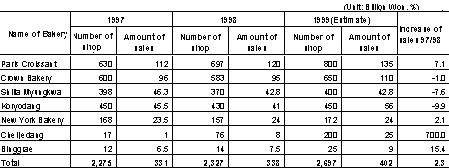
Source: Food distribution year book
Frozen Pizza and Frozen Bakery Products
There are two kinds of frozen bakery product - those aimed at the consumer and HRI segments, like frozen bagels and frozen pizza bases, and frozen products like frozen dough largely aimed at bakers.
The total market size of frozen convenience food in Korea is about US$182 million (200 billion won), which is considered by foreign food companies as a fraction of its potential. However the market has grown very slowly. The market for processed meat products which are mainly hamburgers, mini-hamburgers, breaded port cutlets, chicken nuggets and ham/pork slices for frying is estimated at about 50 billion won. The market for frozen pizzas has been around 24 billion won, and for frozen bagels and other products almost zero.
Table 3. Frozen Pizza Market Size
(Unit: Billion Won)
1997 - 24
1998(Estimate) - 14
* Source: Food distribution year book
Just before the crisis 14 foreign companies had set up marketing organizations for frozen pizzas. Six months later only 2 survived as the market for home frozen pizza collapsed as shown in table 3. Only in early 2000 did Schwan's pizza appear again in selected retail out let's.
In Korea the absence of a conventional oven has prevented many kinds of product despite a recent universal microwave penetration approaching 100%. Basically the home frozen pizza is almost entirely supplanted by the home delivery pizza which provides a higher quality product at about 3 - 4 times the price.
The frozen dough market is considerably larger. The frozen dough market is estimated at 124 billion won when imports and domestic production is included. The frozen dough is aimed exclusively at bakers (including hotel bakeries) and not at the consumer. The Korean consumer does not yet have any clear concept of home baking. The focus groups held for this study showed great interest in the idea of home baking products, but lacked any idea of how these products would be used.
Korean consumers generally have a low opinion of frozen food products. On probing this results partly from the poor quality of many existing products, and partly from the consumer believing frozen products not to be "fresh", and high in preservatives. Thus the idea of "oven fresh" products and "frozen" products seemed contradictory to those interviewed.
The market for bakery products consists of three distinct segments:
- Consumer products sold through the retail chain such as frozen pizza and frozen cakes, oven ready bagels and cake mixes
- Bakery ingredients sold direct to bakeries of all sizes from the largest industrial concern to the smallest window bakery. Yeast, mixes and frozen dough are amongst the most important. These are sold through specialist bakery supply companies.
- The HRI segment which includes frozen dough, oven ready products including frozen pizza, and frozen pizza bases. This includes frozen dough products such as croissants for the coffee shop sector.
1.2. It's Recovering Fast
The Korean economy grew 10.7% in 1999 after a contraction of 5.8% in 1998. By December 1999 retail and wholesale sales were 10% above the December 1997 (onset of crisis) figures. First indications for 2000 are of a 12% growth rate in the first quarter and 7-8% for the whole year. Retail and wholesale sales are likely to be up 10-15% for 2000. Imported products are still going to be more expensive in won terms with the US$ at 1050 - 1150 compared with 840 in 1997 and 800 in 1996.
Like other food areas, the sales of domestic bakery products decreased during the recession, but 7 is expected to grow fast in the recovery. The potential for imports to grow fast in the recovery period is particularly high.
1.3. There is a Premium Sector
The market is being driven by the premium sector of high quality bakeries both in chains like Paris Croissant and hotel bakeries and higher class window bakeries. All types of bakery are seeking more sophisticated and quality ingredients and final products which particularly favours frozen dough and frozen bakery products.
The general retail sector for consumer baking is not yet well developed, but has considerable potential if the product can be cooked in a microwave. Conventional western ovens have a low distribution in Korea estimated at less than 20% of households compared with 100% penetration of microwaves.
The evidence of the Korean bakery market is that consumers are looking for quality at a reasonable price. The difference in price between a cake or loaf of bread in an old fashioned window bakery and an advanced chain like Paris Baguette is minimal, although the quality is much higher in the advanced chain.
Focus groups confirmed the preference of Korean women for better quality and different products. Particularly new categories such as bagels are seen as attractive items.
Three focus groups were conducted especially for this study of young women, women in their early thirties and those in their forties. The income range was moderate to well to do. As food is almost exclusively purchased by women in Korea this was felt to give an indicative response to the issues arising from the products in question. The subjects discussed by the groups were food purchasing habits, attitudes to Canadian food and reaction to a small sample of products supplied by exhibitors to the Canadian Food Fair of March 2000. Further details are available from eabckr@kornet21.net
1.4. There is a Delicatessen Sector
A Korean bakery shop is a retail outlet partially in the process of converting itself into a delicatessen. In addition to fresh baked products, there will normally be a range of imported confectionery, jams, spreads and high quality ice cream. In a smaller selection of bakery shops including those in hotels, there will be hams, processed meats and natural cheeses. A few pure delicatessens are emerging which sell a wide range of quality imported goods. If they did not start out as bakeries, then they are likely to be wine shops.
Both types of delicatessen are now likely to be stocking frozen dough products.
1.5. Bakery is a Non-Traditional Food which Suits Korean Taste.
Bread made of flour is not a traditional Korean product. (Koreans used flour to make pancakes, and made cakes from rice flour). The modern bakery market is a post Korean War product which was initially imitative of the Japanese bakery market in terms of product and taste. In the later 1980s higher value added breads of a western design evolved as sponge cake became cream cake and a market for western style non sweet bread evolved.
Korea now has a large bakery market driven by both large industrial bakers selling products in convenience stores and supermarkets and a fresh products market sold in window bakeries, department stores and hotels. At a mid-point there are also large chains of bakeries baking in central bakeries and also using frozen dough in outlets. Table 4 shows that the number of bakeries has increased during the recession.
Table 4. No. of Bakeries by locality
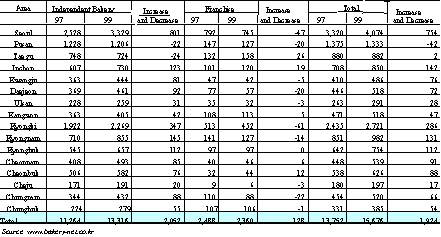
1.6. Importers and Customers Looking for Something New
Importers are looking for new ideas and new products. They are reflecting the fact that the Korean housewife is always looking for new and quality products. There are sharp difference between young Koreans and older Koreans. Heavy users are likely to be over 40 years old.
Korean bakers and consumers are looking for new products in the bakery market. This is a good opportunity for bakery ingredients, frozen dough products, frozen bagels and less probably frozen pizza or frozen pizza bases from Canada.
Changing preferences
The preference for higher quality value-added bread has increased over the past few years regardless of the crisis. During the recession of 1998 the small bakeries selling undifferentiated products and the four large industrial bakeries suffered.
The focus groups showed a warm reacceptance of bagels, and therefore potentially other similar bakery products. On the question of frozen pizzas consumers were luke warm. All frozen pizza products on the market were seen as greatly inferior to a home delivered pizza, and consumers were willing to spend four times the money to get a quality product.
Koreans said that they expect their freezers to be full of frozen fish and meat and ice cream had little space for a large pizza box. To succeed a frozen pizza would need to be of equivalent taste and quality to a home delivered pizza.
1.7. The Distribution System is Changing
The retail structure of Korea is changing. The major feature is the rapid growth of hypermarkets, several of which are foreign owned and might be more willing to take or showcase foreign products.
| Ownership | Chain Name |
|---|---|
| Lotte | Magnet Stores |
| Shinsegae | E-mart |
| Carrefour | Carrefour Korea |
| Walmart | Makro Korea |
| Costco | Costco |
| Samsung-Tesco |
The only hypermarket actively soliciting foreign business in early 2000 is Costco, which has only three outlets. Only container loads will be accepted.
Bread products are seen as something to buy fresh and locally, and not at a weekly visit to the hypermarket.
There are therefore only very limited new distribution opportunities for bakery products. The majority of bread is now sold through bakeries and not through normal retailing, and as noted industrial bakery products are declining.
This means that the potential of the new distribution of hypermarkets and convenience stores in the bakery area is limited unless the Canadian supplier links up with one of the four Indus- trial bakery companies.
Diagram 5 and table 6 shows that both hypermarkets and convenience stores are growing, but this does not appear to impact the bakery chains and window bakeries.
Diagram 5. Growth of Hypermarkets

Table 6. Growth of Convenient Stores (CVS)

Source: Food Distribution Year Book ((1) Excluding e-commerce effect)
Voluntary chain convenience stores do not belong to the major chains
and do not have central distribution
CVS sales are much more concentrated on convenience foods and fresh foods than hypermarkets which sell more household products. For bakery products, except ready mix for pancakes and similar products, convenience stores probably sell 30% of the value sold by hypermarkets. However as will have been seen there are almost three times as many bakeries as convenience stores.
The two product areas where the new distribution channels could help Canadian products are in oven ready home bake products either frozen or in ready mix packets, or frozen cakes. Neither are popular areas. Sarah Lee frozen cakes were imported to Korea from Australia during the 1990s but discontinued during the economic crisis, but demand and distribution was never large.
Home baking is only just being introduced, and the idea of a Korean housewife baking a readymix cake is still seen according to focus groups as alien. The growth of the hypermarkets, convenience stores and e-commerce clearly offers a future opportunity for Canadian exporters. However accessing hypermarkets at the present time will be difficult.
Hypermarket
Opportunities:
- Hugely simplified sales channel
- Access to very large market share
Problems:
- Chains are exclusive about products
- Demand high discounts
- Demand advertising and promotion support
Accessing CVS stores is much simpler as CVS are always willing to churn product to put something new on the shelf alongside the best sellers. This gives a narrow window of opportunity to prove that the product will be a best seller.
CVS
Opportunities:
- Simplified sales channel
- Access to a sizeable market share
- No resistance to new products
Problems:
- If product does not sell well, then will be replaced.
- Supplier will probably be asked to take back unsold product
- Advertising campaign to back up window of opportunity required
If access to the hypermarket or e-market system is achieved then sales should grow rapidly. This will require considerable work to build relations and incentives with the buying chains.
1.8. Tariffs are not a barrier
The tariff rate for almost every kind of bakery product or ingredient is 8%. This is low enough not to present a barrier to an imported product from Canada.
2. Weaknesses and Discouragements
2.1. Small Size of Importers.
Although 97% of the market is currently serviced by Korean companies, most of the Korean companies in the bakery segments of interest to Canadian companies are small. Two of the three segments in the market, bakeries and HRI are serviced by a complex network of suppliers, distributors and importers.
There is therefore no specially strong local competition in Korea that would be a deterrent to Canadian exporters. However the importers are nearly all small companies with limited resources. These companies or individuals have built up relations with particular suppliers and are not necessarily willing to take risks on new products.
Canadian exporters are going to have to push into the market rather than be pulled in by demand. Even though bakers and consumers may be looking for new products, most importers will be cautious.
2.2. No Korean "Canadian Image"
The Korean consumer does not have a strong image of Canadian products as opposed to US, European or Australian product. Focus group work showed that Korean housewives and young people generally had a good expectation of Canadian food products. They were generally disappointed in the product itself and particularly the packaging which was found to be not attractive nor to Korean taste.
Koreans prefer Korean products. Conventional amongst multinational food companies' wisdom is that Korean will tend to buy "made in Korea" although they can be tempted by attractively presented and made to taste products if the consumer is convinced that the product is superior. Since all wheat is imported, bread is governed by the concept of freshness rather than country of origin.
2.3. Must Be Container Load
The minimum unit of sales into Korea is the container load. The Canadian exporter must find a Korean partner willing and able to distribute a container sized consignment or work with a Canadian consolidator who can arrange part loads.
Arranging container loads will be more difficult in the area of bakery products because of the small size of importers and the low volume each handles. The importer may be able to suggest ways to assist in consolidation.
2.4. Import Procedures May Be a Problem
The Korean customs and quarantine system works on a "reliability" basis. A new importer, a new exporter or a new product will normally attract a full inspection, which should take a maximum of 18 days including any relevant testing. Once the bone fides of the importer, exporter and product are established, documentary inspection should be sufficient and the product should clear within 5 days.
Importers of all food products report occasional disruptions due to new procedures, new officials or complaints from competitors.
3. Strengths
3.1. Price
The Canadian product has an advantage of price of raw materials compared with the Korean manufacturer. The price per kg in Table 7 will give an indication of how expensive the Korean product is. A rough check on the landed Korean retail price for a Canadian bakery and frozen dough are that it will be 2.17 times higher than the Canadian FOB price, but Korean products are selling at a dumping price from time to time, particularly during sales promotion period. Korean consumers will not be deterred from paying a premium and will expect premium to be reflected in the price. The same can be applied to bagged flour in which the price the consumer pays is well above the international level.
Table 7. Price of Frozen Pizza

The wholesale market and HRI market are much more price sensitive than consumer markets. Korean bakers and restaurants will pay less for quality than Korean consumers, and will rarely be willing to pay more than 10-20% above a Korean competing product.
3.2. Know-how
Baking fashions, until recently were based on fashions in the Japanese bakery market. Korean bakers know little about western baking. Therefore Canadian bakery product companies have a considerable advantage in terms of know-how. However this will need to be transferred by the company.
All bakery ingredients companies run schools for bakers, either as part of their own operations or in conjunction with the Korea Bakery Association to which about 60% of bakers belong.
It should be noted that Korean bakers bake a variety of bakery products which are different in flavour, texture and taste to western bakery products. Matching these products would probably require a reverse flow of know-how, and investment in time /resources by a Canadian company to learn about Korean tastes and preferences, particularly for frozen finished products. This is an important step, to ensure that Korean tastes are satisfied.
3.3. Quality
Imported products can be projected as higher quality, and therefore more positioned in to the premium market.
Interviews with a selection of upper class window bakers showed them exceptional interested in improving or innovating their products and therefore receptive to new ingredients.
During the crisis the sale of high quality margarine has risen, and the low quality margarine companies have become bankrupt.
Customers stress quality, trust and freedom from preservatives and additatives as the key issues in choosing a product. This can be projected as a Canadian advantage. However the Korean consumer is becoming concerned about Genetically Modified Organims (GMO), and future legislation may require labels to state whether the products contain GMOs. Korean consumers are unlikely to purchase products labelled as containing GMOs.
3.4. Potential to Create A Canadian Image
In discussion in focus groups conducted for this study the Korean consumer has a high, but unclear, expectation about Canadian product. There is a strong potential to create a "Canadian" image in the mind of the consumer but this cannot be done by a single food manufacturer alone, but could be developed to the benefit of many Canadian producers on a collective or collaborative basis.
4. Threats
4.1. Competitor
A successful new product imported by one importer is likely to lead other importers to seek comparable products through their overseas contacts resulting in lower sales/returns for innovation. Experience in this respect suggests that this is not a very great threat except where consumer HRI frozen bakery products such as bagels or pizza are concerned.
Of the various products studied, bakery products probably have the lowest threat value in term of "me too" products.
Table 8. Frozen Pizza Turnover Status by Companies
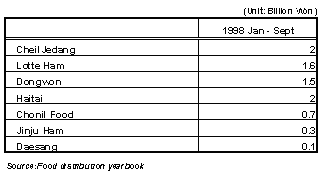
Korean companies may also imitate successful new bakery products, but given the small size and limited know-how of the competing companies, this is less of a risk than in many product areas.
5. Market Strategies
The Korean bakery market is a relatively difficult market to get started in. It requires investment, knowledge and patience. Until a secure marketing organization is set up it cannot be an orderbook market. To establish a presence in the Korean market will require proactive measures by the Canadian exporter. Unless any investment in the market is well planned, the development of long term business in the bakery product sector is not likely to be attractive. The following set out possible approaches to the Korean market and the kind of investment needed.
5.1. Looking for a Niche Market
Niche markets are more suited to the bakery market and the size of importers of bakery product.
Creating a mass market takes time and money. A Canadian exporter will start by seeking a way to establish a niche market. The following table shows the price build up for bakery products, and the potential exporter can multiply through his product to obtain an idea of the potential retail price in Korea and compare it with competitors.
Table 9 shows the price build up for bakery products. Because of the need for chilled distribution, frozen dough will require a higher distribution margin, and the higher end of each margin should be used in Table 9.
| FOB | Plus |
| CIF | 10% |
| Tariff | 8% |
| Other costs | 5% |
| Importer | 15-20% |
| Distributor | 10-15% |
| Retail Margin | 10-15% |
| VAT | 10% |
Retailers attempt to return out of date stock and an allowance for returns must be made of 2-3%.
For a niche market approach the company would either use an agent or import and distribution company. In the case of an agent he would be responsible for finding a freight forwarder and physical distribution. The companies importing bakery products are listed in the appendix and could be approached to verify interest in Canadian products.
Most of the companies listed are expert at handling bakery products and distributing them to bakers. One company should be the first port of call and this is Seoul-Heinz which has one of the largest bakery product portfolios in Korea having about 45% of the margarine market, but a strong interest in new products.
5.2. Looking for a Mass Market
To reach a mass market would require a successful product aimed at the consumer. As noted above neither the mix or homebake category has really established itself in Korea. Nor have frozen cakes achieved a very high volume of sales.
All three are categories that have a future potential. Women discussing their cooking habits in focus groups did not show great enthusiasm for home baking except in using bread making machines, and in using ready mix products for traditional Korean pancakes. These pancake mixes and hotcake mixes are produced by Taehan Flour Mills and by Korea Pillsbury. Successful imported products would face imitation from these two sources.
The case of Sarah Lee Frozen Cakes is also an instructive example. Sarah Lee cakes were imported from Australia by a small import company. These frozen cakes were only accepted by a limited number of large supermarkets. Although Korea has about 2000 large supermarkets which before the rise of the supermarket might have handled 25%-40% of all sales of a western product, the importer could only get about 20 supermarkets to handle the product.
From the supermarket's point of view the product took up a lot of space in scarce freezers, and was slow moving. This facts amounted to a decision not to stock for most stores. Had the importer been much larger or had greater support from Sarah Lee, an TV advertising campaign would have both reassured the retailer and increased sales.
The pricing structure of the Korean market is such that a mass market in imported bakery product could be created if the FOB price can be competitive.
A mass market means success with a brand name which can be supported by advertising and trade promotions. A brand name can only be established with the Korean consumer through intensive TV advertising geared to Korean take. To achieve this it would normally be necessary to find a large company which will to act as partner/distributor.
In both cases the willingness to invest in advertising and promotion will be essential and a first year budget of US$3 million might be appropriate.
Only one hypermarket, Costco, is currently a major importer. Costco has only three outlets and naturally wishes to be sure that a container load can be sold.
A less risky and lower cost way to a mass market is to team up with a major Korean food company. Cheil Jedang, Korea's largest food company, is seeking to expand its bakery business at both retail and food service level and may be prepared to "partner" with Canadian companies. Cheil is a leader in the Korean market and other companies will follow.
5.3. HRI Market
Apart from bakeries themselves which usually have an on-premise area for consumption, most other HRI outlets do not commonly use bread products, since they specialize in Korean, Japanese or Chinese food. There are however about 8,000 western restaurants in Korea and many cafes now supply cakes, toast or sandwiches as well as coffee.
The main markets are hotel bakeries which are served by their own bakery establishments, and coffee shops.
The HRI market is a dispersed field, but generally has a large number of independent wholesale agents supplying restaurants and food outlets.
The KTSC is the major supplier of hotels. It does not have an exclusive right, but claims the widest distribution to more than 700 hotels and tourist restaurants.
5.4. Alternative Approaches
The hypermarket sector is growing, but it is predominantly using domestic product. The following are "breakthrough" strategies.
TV Shopping
If being on TV is the requirement of mass success, blocking a space on a TV shopping channel is a good way to start a business. Food products are particularly well suited to the target audience. Channel 39, the most progressive has just been acquired by Cheil Jedang. The other shopping channel is owned by L-G. The shopping channel companies can be approached direct.
Channel 39 recently advertised a bread making machine and sold 10,000 machines.
E-commerce
According to surveys 81% of Koreans have visited an e-shopping mall and 51% have bought something. Inclusion of product in a company's cybermall requires very little stock and no shelf space. This is a business still in its infancy. The biggest cyber shopping mall is run by Lotte Department Store, but there are currently 139 other malls to choose from.
6. Do you measure up to the Korean market?
This section allows you to measure your ability against the Korean market without further investment.
6.1. Product
Do you have a product which fits the Korean market in terms of taste? The preferred size in Korea is:
Table 9. 10 High Ranked Pizza in January 2000

Sales value: sales per a month
HRI will take catering packs, and premium products could have other sizes.
Frozen Dough
Frozen dough is probably the product with the biggest potential given the demand and its suitability to container loads.
The frozen dough market in Korea is in the early stages of development and the market structure is one sided. Chain bakeries' frozen dough business is well developed, however independent bakeries are somewhat underdeveloped. Chain bakeries' frozen dough market size is 110 billion won(98% of total frozen dough market) in 1999, the growth rate is 44% compared with a previous year. This is because Chain bakeries are more competitive through the use of frozen dough, offering freshness of bread and allowing the franchisee a larger profit margin.
Chain Bakeries
Franchise companies' frozen dough turnover totals about 25% of total domestic turnover. These companies are trying to improve the quality of their frozen dough, expand their product ranges, and are trying to equip themselves with a bake on premises system. At present they use frozen dough for pastries and doughnuts, however they are trying to expand into general bread items by improving techniques in making frozen dough.
Independent Bakeries
In case of independent bakeries, the amount of frozen dough used will increase but the growth will be more limited for the following reasons.
Firstly, the products are not supplied efficiently; this is the main reason why the frozen dough market of independent bakeries is not well developed. Only 4 companies (Seoul Food Industries, CheilJedang, Ottogi and HRS) supply to independent bakeries. However, these companies don't have effective distribution systems. Their target customers are large order bakeries, and they supply the bakeries which order sufficient quantities and are located within a feasible distribution range.
Secondly, lack of product differentiation is a problem. When bakeries use mass produced frozen dough for most of their products, they will loose their product differentiation. Independent bakeries use frozen dough for pastry, cookies and doughnuts. For general and white bread, they endeavor to preserve product differential by producing their own dough.
Given the rapidity of change in Korea, the past may not be a guide to the future, but some 70% of foreign companies dealing with Korea have learnt expensive lessons with respect to agents and partners. Time spent in studying the market and learning who has a successful trackrecord is essential.
6.2. Partner
A Canadian company will want a reliable partner in Korea. Korean business ethics are not always impeccable and in dealing with a small to medium sized company, a credit or reputation check is advisable. With large companies there is less cause for concern.
Korea has changed a great deal and the important issue is whether the partner has the experience and capacity to handle the product, or can outsource it reliably. Older Koreans often approach problems in a very old fashioned way and this adds cost and inefficiency to the process. In general Canadian exporters should take advice of their agent talks too much about "understanding Korean customs". Even without direct payments the exporter may find himself paying for expensive entertainment.
The Confucian nature of Korean society means that a business relationship with a small company is also a personal relationship. With bigger companies the relationship would also be expected to transcend a simple profit and loss relationship.
The partner must also recognize the long term commitment that is needed and must have contacts in the food business that know how to run a chilled distribution service.
6.3. Package
Packaging has two elements, the type of package and the design of the label or other material.
In focus groups, consumers criticized Canadian packaging as being unappealing. The consumers interviewed were generally unresponsive to the packaging of Canadian products in terms of design and colour.
Many Canadian bakery products will not be sold in packages, but where they are, careful attention to testing alternative designs is essential.
6.4. Pricing
Consumers agree that price is an important signal of quality. Importers and the trade agree that quality product may be priced at up to twice the basic price without damaging its appeal to consumers. Importers, distributors and retailers will expect to share in the higher margin structure and this is their incentive to carry and promote this product. Korean consumers may also be willing to accept up to 100% higher prices for a quality bakery product than a Korean equivalent perceived as being of lower quality. This has been demonstrated by new entrants into a wide range of bakery products. Bakers will not pay more than 10 - 20% more for a superior product.
6.5. Willingness to Modify the Product
Korean taste is so unique that it must be studied where it comes to bread and bakery products. Especially for frozen pizza, bagels and dough careful monitoring of alternatives will be essential.
Taste tests in Korea will be required, or guidance by the importing company, or a panel of bakers. If using the last two, it should be remembered that the Korean consumer is innovative, but the Korean trade tends to be conservative. The best taste tests are free samples in-store which most bakery shops will organize without cost.
Koreans have strong ideas about the product. Where Korean companies have sourced product from overseas they have flown taste panels to the originating country to get the taste right.
7. How Do I Start?
7.1. Start as Simply as Possible
No potential exporter of bakery products should start without a week long visit to Korea. But this first visit should be well prepared without committing to an agency relationship first. It should include visits to several large food manufacturers, bakeries, importers, and possibly hypermarket buyers, the KTSC and one or two hotels.
The preparations for a visit would begin with fax contact with selected importers to see whether they have an interest in importing bakery products from Canada. The list of importers is appended to this section and the importers are graded according to information currently available.
It is possible that even after a visit there will be a minimal response, and that one of two decisions must be made, to look for a suitable agent, or to attend a trade show or make an independent assessment.
- Agents may be found either by a professional consulting company, an embassy or a trade organization such as AFTAK.
- It is more likely that they will be the result of a fair trade visit. The next Canadian food trade fair will be held in Seoul in March, 2001. These are also international bakery exhibitions.
- The final way is to make a special visit. This would normally follow on one of the other routes in any case. The aim of a visit should be to inspect the market for bakery product, visit some of the potential partners and distributors.
In selecting an agent attention should be given to his proven track record, and to whether he has an organization which can deliver the product to the retail or HRI outlets, or whether he is only the first in the chain of middlemen. Note that the suggested price build-up in Table 9 allows for only two middlemen, an importer and a distributor.
Before leaving Canada an adequate supply of brochures and name cards (100 is not enough) should be prepared. At the same time at the start of the process, the company website should be reviewed. Current big Korean company and hypermarket practice is to look at the website on receipt of a fax or inquiry.
The Canadian company may be judged purely on its Canadian website and on this may hang the acceptance of a proposal for a meeting.
7.2. Attend the Next Canadian Trade Show
There is no better way to try to enter the Korean market than by exhibiting at the next Canadian Trade Show. In 2000 there were more than 450 visitors all interested in Canadian products. Importers could also exchange experience with one another and Embassy specialists.
7.3. Getting a Container Load Together
A single container of bakery product would require about 40-100 outlets willing to take the product, or a major promotion to move the stock.
The alternative is to share a container with an existing shipping in a consolidation move. Freight forwarders in Canada will be able to identify consolidation opportunities.
7.4. What to Watch Out For
Physically Getting the Product Cleared
Complaints about customs procedures on clearance for food products continue. Both Amcham in its annual report on business conditions in Korea and the Investment Ombudsman which handles business complaints find that arbitrary action by quarantine and customs individual officers fill up their case books.
The first time is likely to be the worst and the following are the most common causes of delay:
- Paperwork not in order. The necessary documentation on contents are inadequate
- Korean labels proposed for the product are too small or do not conform to specification.
- Products tested reveal minimal trace elements of proscribed products.
The second and subsequent shipments should go through much more easily unless:
- Change in local official
- Change in local regulations
2000 is predicted to be more difficult than 1998-1999 because the rise in imports will encourage nationalistic officials to look for exceptions, meaning that due diligence will be even more important, to avoid problems.
7.5. Update on Regulatory Issues
Trade Regulations
Korean regulations are notorious for their complexity and for changing frequently. Every attempt has been made to alert the Canadian exporter on possible problem areas, but inquiry should be made to the Embassy or to existing importers on whether there have been any relevant changes.
The importation of preparation with a basis of butter HS2102-90-9020 into Korea must not contravene the Livestock Processing Law.
HS1901-20 mixes and dough for preparation of baker's wares is governed by the grain administration law any may be imported by recommendation of the Ministry of Agriculture. Other importers report that this has not been an impediment in the past
Tariff Rates
- The tariff for bakery imports under HS HS1905 in 2000 is 8%.
- The tariff for bakery yeast HS2102-10-3000 is 8% in 2000.
- The tariff for HS 2102-90-9020 is 8% in 2000.
- The tariff for HS1901-20 is 8% in 2000.
Inspection of Goods
Inspection of goods or their labels / packaging is necessary to determine:
- The value of the goods for customs purposes and their dutiable status;
- Whether the goods must be marked with the country of their origin or are in need of special making or labeling. If so, whether they are marked in the manner as prescribed;
- Whether the shipment contains prohibited articles;
- Whether the goods are correctly invoiced;
- Whether or not the goods are in excess of the invoiced quantities.
To be specific, customs officers will ascertain the quantity of goods imported, making allowance for shortages under specified conditions and assessing duty on any excess.
The showing of the contents of each package on the invoice, the orderly package of the good, the proper marking and numbering of the packages, and the placing of the corresponding marks and numbers on the invoice facilitate proper duty adjustment according to actual volume of goods brought in and the ascertainment of whether any excess goods are contained in the shipment. If any package which has been designated for inspection is found by the customs official to contain any article not specified in the invoice with fraudulent intent on the part of the seller, shipper, owner, or agent, the contents of the entire package in which the excess goods are found are subject to investigation for possible violation.
Appendix 1. Further Information on Import Procedures and Regulations
1) Local customs Commissioners or Directors may deploy a special inspection team for fast processing for "fresh food". Processed meat should not be included as "fresh food" but the discretion of local authorities in case of chilled products should be noted.
2) In principle, the inspection should finish within 5 working days from receiving the import report. The imported foods etc. subjected to incubation test such as canned or bottled foods and retortable pouched foods, and the other imported foods etc. subjected to inspection by special order from the Commissioner of Korea Food and Drug Administration, are exempted from the processing date limit.
3) The test items for the laboratory inspections and the random sampling inspections for the imported foods, equipment and containers/packages are referred to in Appendix 4 Primary Laboratory Analysis List for imported foods etc. As noted this has not been applied to Korean processed meat products.
Inspection and Clearance Procedures for Foods
Diagram shows the inspection procedures.
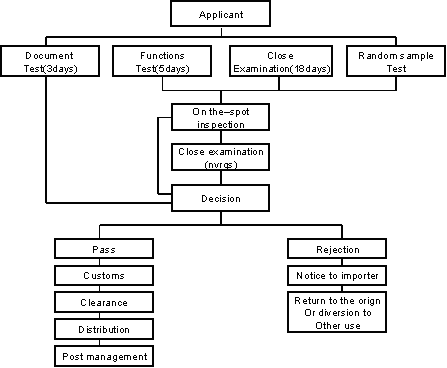
The documentation required is:
a) Certificate of Quarantine by Orign Country
b) B/L
c) Import Declaration
Need to attachment of copy of Korean label
(manufacturing progress, Ingredient, shelf life)
d) Copy of Livestock Import Sales Certificate
1) Application for food safety inspection
Since the imported foods and domestic foods are regulated by the Food Sanitation Act identically, the importer would normally must make an application for a safety inspection to one of the six Regional KFDAs which are substructures of the Korean Food and Drug Administration (KFDA). As the pre-arrival application system was introduced in August 1995, an arrival application can now be conducted five days before the arrival of the shipment. In the case of processed meat this would normally be handled by the NVRQS.
The criteria and the types of inspection
a) Confirmation of safety
- Residual test for pesticides, antibiotics, heavy metals etc.
- Confirmation of micro-organisms
- Test of toxicological substances such as aflatoxin
- Perishability test
b) Confirmation of standards and specification
- Confirmation of meeting the standards provided by the Food Code
- Confirmation of additives in compliance with provisions of the Food Additives Code
c) Provision of consumer information
- Examination of labeling in Korean (nine items including main ingredient, etc.) to confirm the suitability of information for consumers
d) Ensuring the soundness of food
- Protection of sound dietary habits through the elimination of unsuitable foods
2) Procedures after rejection of food
a) Food that has not passed the KFDA inspection is destroyed except in the following cases:
- The food rejected is to be returned to the exporting country or converted for other use as non-edible products.
- When the sanitation hazard sanitation can be eliminated by processing, heating or selection after customs clearance
b) Inspection Procedure of Imported Food
Imported food import - Declaration - Food & Drug Administration - Regional Food & Drug Administration - Health and Environment Research(as needed) - Institute at City and Province - Document Test - Organoleptic Test - Laboratory Test - Random Sampling Test - Customs Office(Pass) - Customs - Clearance (In case of rejection: return to the origin or diversion to other use - destruction)
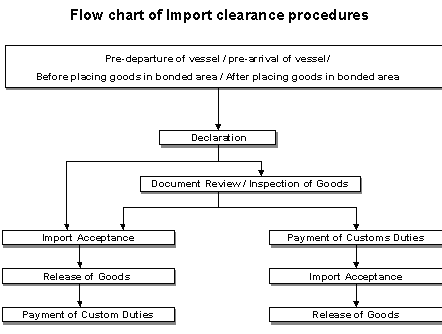
3) Improvement of the imported food product inspection system
a) Compliance Sampling Group (subject to mandatory laboratory testing):
- New-to-market products
- Products with a record of violation
- Products with prior information of sanitary risk
- Products falling under the health supplementary products of the ginseng products category, for which laboratory testing is compulsory.
b) Surveillance sample groups (Products random sampling for laboratory testing)
- Same products from same producer which passed the laboratory testing.
- Raw materials which a manufacturer imports to make his own products.
Appendix 2. Import History and Data
Korea has undergone a dramatic change during the last two years, so that the imports of 1998 and 1999 broke the trend with the past. In the case of HS1905, the peak was 1996, and 1997 represented a dramatic reduction. Imports in 1999 were only one third of 1996. The same pattern was reflected in other products except mixes and yeast where growth can be observed.
Diagram 2-1. Mixed and Dough and bakery ingredients (1901 20) Imports by Country 1996-1999

Diagram 2-2. Mixed and dough and bakery ingredients (1901 20) Imports by Country 1996-1999

Diagram 2-3. Preparation with a basis of butter (2106 90 9020) Imports by Country 1996-1999
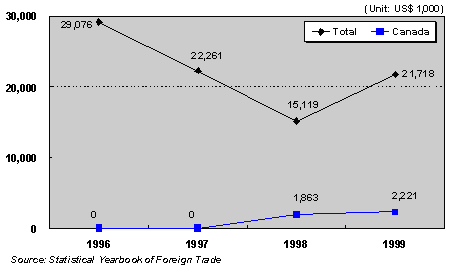
Diagram 2-4. Preparation with a basis of butter (2106 90 9020) Imports by Country 1996-1999
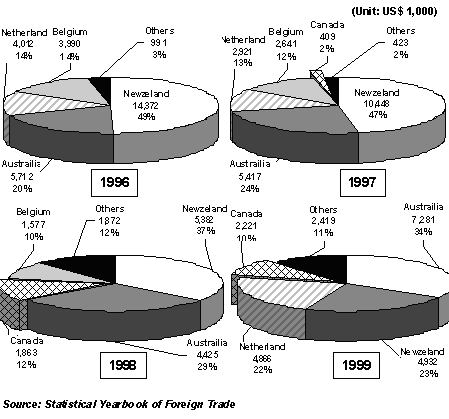
Diagram 2-5. Bread, pastry, cakes, biscuits and other bakers' wares (1905) Imports by Country 1996-1999

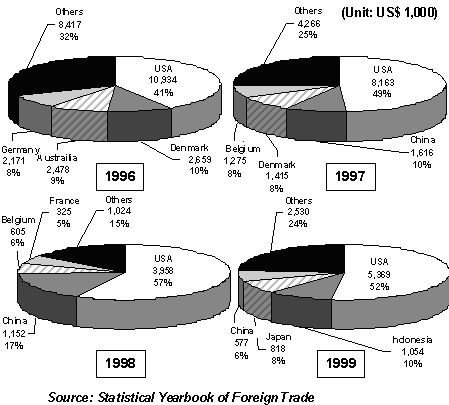
Table 2-6. Import by Country of Origin: 1905 Bread, pastry, cakes biscuits and other bakers' wares
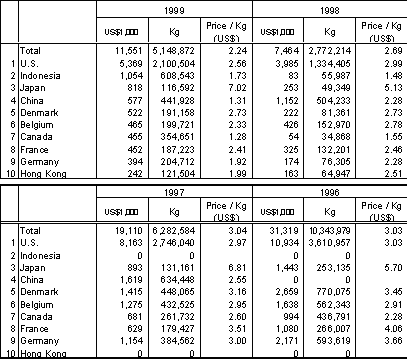
Diagram 2-7. Bakery yeast (2102 10 3000) Imports by Country 1996-1999

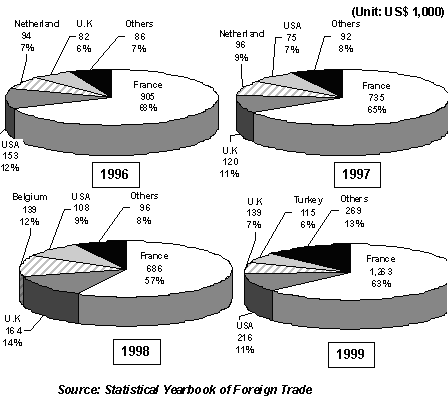
Table 2-8. Import by Country of Origin: 2102 10 3000 Bakery yeast

Table 2-9. Import by Country of Origin: 2106 90 9020 Preparations with a basis of butter
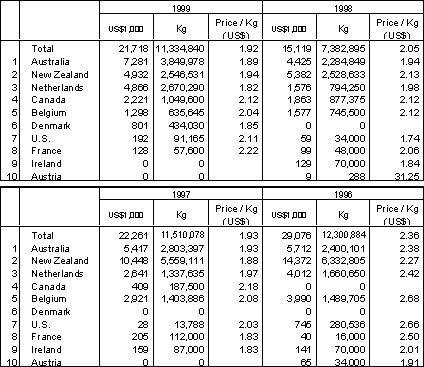
Appendix 3. 2000 Strategy of Bakery Companies
The following shows the strategy of high class Korean bakery chain companies which indicates the perception of how the market is developing.
Paris Croissant
- Factory was extended in Oct. 1999.
- Doubled production of frozen dough.
- Supply more frozen dough for freshness.
- Trying to make high-class image by no discount sales event.
- Frozen dough rate: 50% of total turnover
- Expend frozen dough product ranges
Crown Bakery
- Successful PPL strategy in 1999: Yam cake & Sando
- Preparing new C.I.
- Frozen dough rate: 50% of total turnover
- Enlargement of master baker system for freshness
Shilla Myung Kwa
- Cash back service: cooperate with Samsung credit card
- Internet service
- Special goods on every week event
- "Self bakery shops" opened at Shinsegae department in Myungdong and Inchon to sell frozen dough for home users. Frozen dough for home users are sold about 600,000 - 700,000won per day. Shilla will expend frozen dough supply for home users at each shop.
- Frozen dough rate: 38% of total turnover
Tour Les Jours (CheilJedang)
- Introduction of screen phone system at each bakery for communication
- Mileage customer card in April, 1999(first introduction in bakery business)
- Will increase cake turnover form 25% of total turnover to 40% by direct production.
- Will enlarge frozen dough market by aggressive PR and quality improvement.
- Will be the frozen dough specialist company.
- Total turnover in 2000: 40 billion Won (Frozen dough rate: 65% of total turnover)
Koryodang
- Bake-off system at each shops
- Enlargement of frozen dough production
- Build brand power in 2 years
- Frozen dough rate: 40% of total turnover
- Bake off system: 60% of shops
New York Bakery
- Changed of brand name in Apr 1999 : " Company NewYork"
- New CI will be applied to all member shops.
This summary indicates the rapid rise of frozen dough as a category within an important segment of the bakery industry.
Diagram 3-1. Food preparations of flour, meal, starch or malt extract (1901) Imports by Country 1996-1999
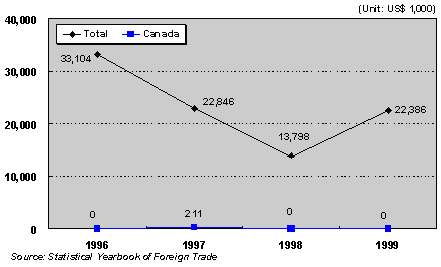
Diagram 3-2. Food preparations of flour, meal, starch or malt extract (1901) Imports by Country 1996-1999
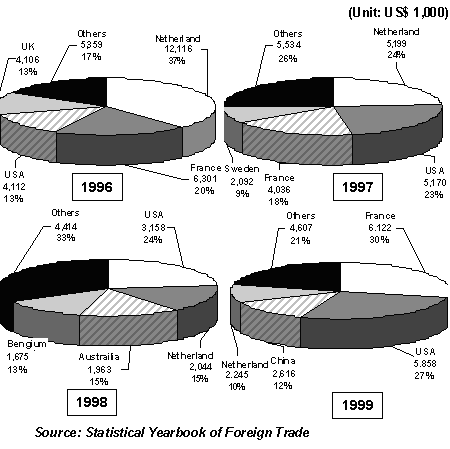
The import of frozen dough products is only just beginning, but already includes Canadian products handled by the local company HRS. This is expected to grow rapidly in the future.
Appendix 4. Frozen Dough
Table 4-1. Sales Status of Frozen Dough for their own Franchises
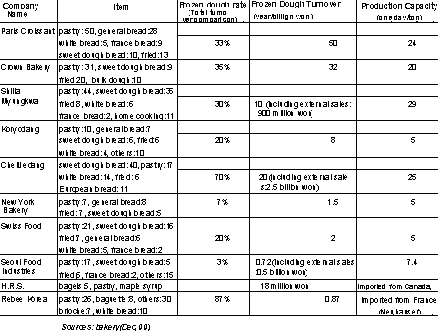
Table 4-2. External Sales Status of Frozen Dough

Appendix 5. Importers of Bakery Products
Table 5-1. Frozen Dough Importer Status

Table 5-2. Frozen dough sales price for home users

Table 5-3. Importer & Sales Company of Imported bakery ingredients

Table 5-4. Bake Plus (importer & sales company of bakery ingredients) (1)
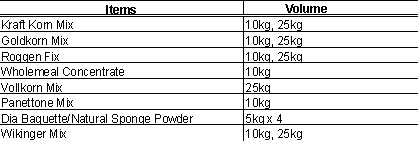



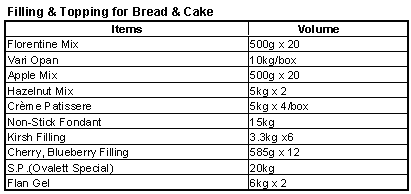
Table 5-5. Bake Plus (importer & sales company of bakery ingredients) (2)
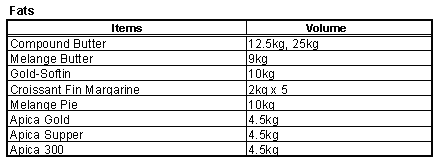

Appendix 6. Importers
| No. | Code | Company Name |
Presi dent |
Tel. | Fax | Zip Code |
Address | |
|---|---|---|---|---|---|---|---|---|
| 1 | 751469 | Nong Shim Co. Ltd | M | Lee, Sang Yoon | 02-820- 7114 |
02-716- 5901 |
156- 010 |
Shindaebang-dong, Tongjak-gu, Seoul |
| 2 | 877604 | B-R Korea Co. Ltd | Han, Jung-nam | 0446-877- 5031/1 |
0446-877- 5030 |
369- 830 |
34-12, Yongsong-ri, Samsong-myon, Umsong-gun, Chungbuk | |
| 3 | 1126 0192 |
Jachin Co. Ltd | Min, Hwan-ki | 02-512- 2058 |
02-512- 2059 |
135- 120 |
Fl2 Yangyoung B/D, 569-17, sinsa-dong, Kangnam-gu, Seoul | |
| 4 | 1152 8515 |
Costco Whole Sale | M | Donnald E. Burdic | 02-679- 1234 |
02-630- 2660 |
150- 103 |
65, Yangpuong-dong, 3-Ga, Yongdungpo-gu, Seoul |
| 5 | 1161 8061 |
Han Chun | Min, Hwan-ki | 02-797- 5271 |
02-797- 5272 |
140- 200 |
36-35, Itaewon-dong, Yongsan-gu, Seoul | |
| 6 | 2974 11 |
Je Won International Corp | Lee, Woo-hyuck | 02-998- 5151 |
02-998- 5151 |
142- 073 |
Jewon B/D, 394-46, Suyu 3-dong, Kangbuk-gu, Seoul | |
| 7 | 1129 3965 |
Jin Hwa F.I. Co. Ltd | Kim, Jin-young | 02-784- 8694/5 |
02-784- 8696 |
150- 010 |
RM 801, Life Combi B/D, 61-4 Youldo-dong, Yongdungpo-gu, Seoul | |
| 8 | 1118 2870 |
U.K. Probaker Ltd | Kim, Ung-il | 02-567- 7015/6 |
02-539- 7241 |
135- 282 |
Richmond B/D, 977-12, Daechi-dong, Kangnam-gu, Seoul | |
| 9 | 1162 2174 |
Pilssbury Korea Co. Ltd | Scoot K. Flora | 02-508- 8500 |
02-561- 5079 |
135- 280 |
968-1, Daechi Dong Kangnam-gu, Seoul | |
| 10 | 1111 9344 |
Shinwoo Food Chemical Co. Ltd | Kim, Nam-hyun | 02-522- 0700 |
02-582- 6901 |
137- 070 |
RM 102, Seccho B/D, 1597-4, Seccho-dong, Seccho-gu, Seoul | |
| 11 | 1124 6482 |
Myung Sae Food Co. Ltd | Lee, Myung-ho | 0344-908- 3317 |
0344-903- 3317 |
411- 351 |
FL4, Banckma Plaza, 751-1 Madu 1-dong, Ilsan-gu, Koyang city | |
| 12 | 1123 9055 |
Daesun Flour Miles Co. Ltd | Park, Kwang-hei | 02-2636- 3100/6 |
02-2636- 3107 |
150- 090 |
3-9, Mullae-dong, Yongdungpo-gu, Seoul | |
| 13 | 1107 1107 |
Garim Co. Ltd | Chung, Doo-shick | 032-819- 0012 |
032-819- 0018 |
405- 310 |
Namdong Industrial Complex 128-4, 697-3, Gojan-dong Namdong | |
| 14 | 841 616 |
Doosan Corporation | M | Ko, Chong-chin | 02-3398- 1557 |
02-3398- 1521 |
150- 096 |
13-6ga, Mullage-dong, Yongdungpo-gu, Seoul |
| 15 | 1126 1144 |
West Gin BAkery Products Co. Ltd | Koo, Bon-heung | 02-443- 6071 |
02-449- 6074 |
465- 190 |
359 Jamil-dong, Hanam-si, Hyunggi | |
| 16 | 1113 3674 |
Montblanc Trading Corporation | Suh, Il-man | 02-412- 9268 |
02-763- 9269 |
138- 229 |
217-2, Chamshilbon-dong, Songpa-gu, Seoul | |
| 17 | 7520 59 |
Tong Yang Confectionery Corp. | M | Tam, Chul-kon | 02-710- 6223 |
02-715- 8280 |
140- 715 |
30-10, Munbae-dong, Yonsan-gu, Seoul |
| 18 | 1404 6175 |
Doo Young Co. Ltd | Hong, Young-pyo | 032-589- 3117 |
032-589- 3117 |
401- 070 |
294, Songnim-domg, Tong-gu, SEoul | |
| 19 | 1148 2695 |
Stange Korea Co. Ltd | Kim, Gun-Il | 0417-568- 1015 |
0417-568- 8218 |
330- 280 |
Shindang-dong, Chonanshi, Chungnam | |
| 20 | 1146 8857 |
CJ Corporation Ltd | Chun, Joo-wook | 02-726- 8367 |
02-726- 8379 |
100- 095 |
500, 5ga Namdaemun-no, Chung-ku, Seoul | |
| 21 | 1133 2873 |
Golden Gate Corp | Lee, Ha-ho | 02-558- 1240 |
02-568- 5888 |
135- 080 |
788-15, Yuksam-dong, Kangnam-gu, Seoul | |
| 22 | 1116 7035 |
Campbell Soup Korea Ltd | Spelt Leendert | 02-562- 4901 |
02-3452- 3512 |
135- 080 |
FL8 Youngnam B/D, 677-6, Yuksam-dong, Kangnam-gu, SEoul | |
| 23 | 809 067 |
Korea Tourist Supply Center | M/ HR I |
Yoo, Hyo-hi | 02-458- 3291/8 |
02-458- 8052 |
143- 180 |
255-5, Neung-Dong, Kwangjin-gu, Seoul |
| 24 | 1105 093 |
K.J. Entreprise Co. LTd | Park, Nam-soo | 02-3141- 4131/4 |
02-3141- 4135 |
121- 120 |
Dongjin, B/D 461-25, Seokyo-dong, Mapo-gu, Seoul | |
| 25 | 1209 5153 |
K.J. Moolryu | Jung, Kyong- puong |
051-465- 1201 |
051-465- 1203 |
600- 014 |
85-8, Chung-ang Dong 4-Ga Chung-gu, Pusan | |
| 26 | 851 682 |
Korean Air Lines Co. Ltd | HR I |
Shim, Yi-teak | 02-751- 7012 |
02-751- 7081 |
100- 110 |
41-3, Sosomun-dong, Chung-gu, Seoul |
| 27 | 1130 6405 |
Sunin Co. Ltd | Lee, Hyo-ku | 0418-532- 6274 |
0418-532- 1625 |
336- 870 |
594-3, shinnam-ri, Doon-o-myun, Asanshi, Chungnam | |
| 28 | 1131 5708 |
TAe Hwa Exim | Young, Shin-Kwak | 02-563- 7903 |
02-563- 7905 |
135- 090 |
141-31, Samsung-dong, Kangnam-gu, Seoul | |
| 29 | 1100 0576 |
Kyowa Trading Co. Ltd | Lee, Dong-seob | 02-323- 0057/9 |
02-332- 7818 |
121- 210 |
F8, Daeshin B/D, 463-15, Sokyo-dong, Mapo-gu, Seoul | |
| 30 | 502 962 |
Taewon Food Induystry Co. Ltd | Lee, Won-jong | 02-862- 8343 |
345-491- 7909 |
425- 120 |
1125-2, Shingil-dong, Ansan-shi, Kyonggi |
| No. | Code | Company Name |
President | Tel. | Fax | Zip Code |
Address | |
|---|---|---|---|---|---|---|---|---|
| 1 | 8411616 | Doosan Corporation | M | Ko- Chong-chin | 02-3398- 1557 |
02-3398- 1521 |
150-096 | 13, 6Ga, Mullage-dong, Yongdungpo-gu, Seoul |
| No. | Code | Company Name |
President | Tel. | Fax | Zip Code |
Address | |
|---|---|---|---|---|---|---|---|---|
| 1 | 809067 | Korea Tourist Supply Center | M/HRI | Yoo, Hyo-hi | 02-458- 3291/8 |
02-458- 8052 |
143-180 | 255-5, Neung-Dong, Kwangjin-gu, Seoul |
| No. | Code | Company Name |
President | Tel. | Fax | Zip Code |
Address | |
|---|---|---|---|---|---|---|---|---|
| 1 | 877082 | Nhong Shim Kellogg Co. Ltd | Shin, Hyun-soo | 0344-673- 5588 |
0344-672- 0103 |
456- 380 |
142, Sinschyun-dong, Ansong-city, Kyonggi | |
| 2 | 1152 2737 |
Global Tec Korea Lted | Lee, Pi-jong | 02-3446- 7600 |
02-3446- 7604 |
135- 090 |
Rm 1105, Namkyung B/D, 8-2, Samsong-dong, Knagnam-gu, SEoul | |
| 3 | 877 604 |
B-R Korea Co. Ltd | Han, Jung-nam | 0446-877- 5031 |
0446-877- 5030 |
369- 830 |
34-12, Yongsong-ri, Samsong-myon, Umsong-gun, Chungbuk | |
| 4 | 809 067 |
Korea Tourist Supply Center | M/ H R I |
Yoo, Hyo-hi | 02-458- 3291/8 |
02-458- 8052 |
143- 180 |
255-5, Neung-Dong, Kwanglin-gu, Seoul |
| 5 | 970 178 |
Ottogi Corporation | M | Lee, Jung-duck | 0343-21- 2111 |
0343-21- 2140 |
431- 070 |
160 Pyongchon-dong, tongan-gu, Anyang City, Kyonggi |
| 6 | 1143 5943 |
DK Foods Co. Ltd | Kang, Dae-kyung | 02-546- 1990 |
02-545- 2990 |
135- 100 |
RM 202, Samyang B.D. 121-26, Chongdam-dong, Kangnam-gu, SEoul | |
| 7 | 1153 4789 |
Eurus Corp | Lee, Joon-dong | 02-3452- 2471 |
02-3542- 2475 |
135- 090 |
RM202, Teyoung B/D, 161-26, Chongdam-dong, Kangnam-gu, SEoul | |
| 8 | 7520 59 |
Tong Yang Confectionery Ltd | M | Tam, Chul-kon | 02-710- 6223 |
02-715- 8280 |
140- 715 |
30-10, Munbae-dong, Yonsan-gu, SEoul |
| 9 | 841 616 |
Doosan Corporation | M | Ko- Chong-chin | 02-3398- 1557 |
02-3398- 1521 |
150- 096 |
13, 6ga, Mullage-dong, Yongdungpo-gu, Seoul |
| 10 | 851 682 |
Korean Air Lines Co. Ltd | H R I |
Shim, Yi-teak | 02-751- 7012 |
02-751- 7081 |
100- 110 |
41-3, Sosomun-dong, Chung-gu, Seoul |
| 11 | 1116 5804 |
Amokor Distribute Inc. | Jong, Yoon-kim | 02-568- 9820 |
02-567- 8976 |
135- 284 |
FL2, Pyunghwa B/D, 912-8, Daechi 4-dong, Kangnam-gu, Seoul | |
| 12 | 1152 8515 |
Costco Whole Sale | Donnald E. Burdic | 02-679- 1234 |
02-630- 2660 |
150- 103 |
65, Yangpyong-dong, 3ga Yongdungpo-gu, Seoul | |
| 13 | 1144 2789 |
Simplot Korea Inc. | Sim, Dong-ku | 02-561- 4787 |
02-561- 4703 |
135- 080 |
FL3, Daeryoon B/D, 825-25, Yoksam-dong, Kangnam-gu, Seoul |
M = Mass Market
HRI = HRI
No comment means small company only suitable for niche
| No. | Code | Company Name |
President | Tel. | Fax | Zip Code & Adress |
||
|---|---|---|---|---|---|---|---|---|
| 1 | 1136 8577 |
Jenico Corporation | Kim, In-sik | 02-631- 7385/6 |
02-675- 9713 |
150-095 | #4-1, Munraedong-5ga, Yongdungpo-gu, SEoul | |
| 2 | 9414 82 |
Daiah Commercial Co. Ltd | Kim, Choun-kil | 02-365- 0900 |
02-365- 0905 |
120-012 | RM 1818, Youwongolden Tower, 164-11, Chungiongno 2-ga, Sodaemun-gu, SEoul | |
| 3 | 1148 2695 |
Stange Korea Co. Ltd | Kim, Gur-il | 0417-568- 1015 |
0417-568- 8218 |
330-280 | Shindang-dong, Chonanshi, Chungnam | |
| 4 | 6707 60 |
Chocheung Chemical Inc. | Hong, Soon-mo | 02-755- 8261/6 |
02-755- 8267 |
100-102 | Kedong B/D, 68-3, Taepyongro 2ga, Chung-gu, Seoul | |
| 5 | 1112 3402 |
Pizza Hut Korea Co. Ltd | H R I |
Cho, In-soo | 02-3468- 0194 |
02-563- 8378 |
135-090 | Kado B/D, 157-1, Samsung-dong, Kangnam-gu, Seoul |
| 6 | 1118 2870 |
UK Probaker Ltd | Kim, Ung-il | 02-567- 7015/6 |
02-539- 7241 |
135-282 | Richmond B/D, 977-12, Daechi-dong, Kangnam-gu, SEoul | |
| 7 | 2974 11 |
Je Won International Corp | Lee, Woo-hyuck | 02-998- 5151 |
02-998- 6678 |
142-073 | Jewon B/D, 394-46, Suyu 3-dong, Kangduk, SEoul | |
| 8 | 7416 82 |
TS Corporation | Han, Dong-hyock | 02-410- 3173/6 |
032-762- 2484 |
400-201 | 6-14, Ika, Buksung-dong, Chung-gi, Inchon | |
| 9 | 1107 1222 |
Bision Business Co. Ltd | Jo, Chul-hee | 02-539- 9150 |
02-539- 9353 |
135-080 | 748-24 Yoksam-dong, Kangnam-gu, Seoul | |
| 10 | 9890 97 |
Tri-Glow INc. | Kim, Se-jin | 02-3471- 8568/9 |
02-598-7665 | 137-063 | RM115, Samwon B/D, 1024-6, Bangdae 3-dong, Seccho-gu, SEoul | |
| 11 | 9318 01 |
Seoul Heinz Ltd | Suh, Sung-hun | 032-887- 6030 |
032-883- 4745 |
400-103 | 62-3, 3-ga, Shinhung-dong, Chung-gu, Seoul | |
| 12 | 1104 3511 |
Donglim Star Corp | Park, Seong-bae | 02-716- 6910 |
01-717- 7654 |
121-050 | RM1806, Hanshin Officete, 136-1, Mapo-dong, Mapo-gy, Seoul | |
| 13 | 8745 66 |
Shin Yang Trading Company | Lee, Yeoung-gil | 051-469- 6527/9 |
051-463- 6218 |
600-014 | 48, Chungang-dong, 4-ga, Chung-gu, Pusan | |
| 14 | 1127 4276 |
Seo Chang Food Co. Ltd | Kim, Hwa-jung | 02-478- 5411 |
02-573- 8072 |
134-030 | FL2, Wochang B/D, 456-8 Songnae-dong, Dangdong-gu, Seoul | |
| 15 | 1127 5484 |
Newkim Trading | Kim, Dong-hyuk | 02-548- 3443 |
02-518- 6117 |
135-090 | 10-26, Samsung-dong, Kangnam-gu, Seoul | |
| 16 | 9025 86 |
Kinn Co. Ltd | Ro, Hwang | 051-783- 7830 |
051-783- 7845 |
612-061 | 1476-34, Panyo-dong, Haeundae-gu, Pusan |
| No. | Code | Com pany Name |
Presi dent |
Tel. | Fax | Zip Code |
Address | |
| 1 | 425908 | Lotte Samkang Co. Ltd | M | Lee, Jong-kyu | 02-2629- 0114 |
02-2629- 0293 |
150- 096 |
21, Mullae-dong, 6ga, Yongdungoo-gu, SEoul |
| 2 | 931801 | Seoul Heinz Ltd | Suh, Sung-hun | 032-887- 6030 |
032-883- 4745 |
400- 103 |
62-3, 3ga, Shinheung-dong, Chung-gu, Seoul | |
| 3 | 21000102 | Daeshin Foods Co. Ltd | Lee, Jang-hae | 0334-74- 0084/5 |
0334-74- 0086 |
456- 930 |
58-7, Dokbong-ri, Yangsong-myan, Ansong-gun, Kyonggi | |
| 4 | 930417 | Binggrae Co. Ltd | Kim, Ho-youn | 0346-560- 8305 |
0346-560- 8204 |
472- 100 |
344-3, Tongong-dong, Namyangiu-city, Kyonggi | |
| 5 | 11005625 | Samlip Oil & Fats Co. Ltd | Yoo, Young-jin | 0343-53- 6600 |
0343-51- 2005 |
437- 070 |
196-3, Cjean-dong, Uiwang-ri, Kyonggi |
|
| 6 | 970178 | Ottogi Corporation | M | Lee, Jung-duck | 0343-21- 2111 |
0343-21- 2140 |
431- 070 |
160, Pyongchan-dong, Tongan-gu, Anyang city, Kyonggi |
| 7 | 690362 | Lotte Confectionery Co. Ltd | M | Han, Soo-kil | 02-670- 6331/9 |
02-670- 6600 |
150- 104 |
23, Yangpyong-dong, 4ga, Yongdungpo-gu, Seoul |
| 8 | 945770 | Crown Bakery Co. Ltd | Yoon, Young-dal | 02-3415- 2600 |
02-3415- 2288 |
137- 070 |
Socho-dong, Socho-gu, SEoul | |
| 9 | 11003209 | Wonhee Trading Co. Ltd | Chang, Dal-won | 02-365- 5141 |
02-365- 5144 |
120- 190 |
1-1376, Pug-ahyon-dong, Sodaemun-gu, Seoul | |
| 10 | 986337 | Maeil Dairy Industry Co. Ltd | Kim, Jung-wan | 02-3406- 2114 |
02-2276- 1550 |
100- 392 |
TAewang B/D, 162-1, 2ga, Changchung-dong, Chung-gu | |
| 11 | 900928 | CJFD System Co. Ltd | Lee, Kuck-soo | 051-260- 0262 |
051-260- 0299 |
604- 040 |
1037, Chamgrim-dong, Saha-gu, Pusan | |
| 12 | 11068934 | Wonwco Corporation | Lee, Sung-youl | 02-786- 7441/5 |
02-786- 7445 |
150- 010 |
RM501, Chungmoo B/D, 44-15, Yoido-dong, Yungdeungoo | |
| 13 | 435125 | NZMP Korea Ltd | Lee, Tong-soo | 02-749- 6961 |
02-749- 6968 |
140- 150 |
FL3, Chungyong B/D, 98-38, Kalwol-dong, Yongsan-gu, Seoul | |
| 14 | 831121 | Donsguh Companies Inc. | Lee, Chang, hwan | 02-716- 7731 |
02-716- 7862 |
121- 040 |
FL 10, Yoodong, B/D 546, Dohwa-dong, Mapo-gu, Seoul | |
| 15 | 297411 | JeWon International Corp | Lee- Woo-hyuck | 02-998- 5151 |
02-998- 6678 |
142- 073 |
Jewon B/D, 394-46, Suyu 3-dong, Kangbuk-gy, Seoul |
|
| 16 | 191768 | Seine F.M. Co. Ltd | Cho, Suk-hee | 02-522- 2351 |
02-522- 2355 |
137- 063 |
Haewae B/D, 537-6, Bangbae-dong, Seccho-gy Seoul |
|
| 17 | 752059 | Tong Yang Confectionery Co. Ltd | M | TAm, Chul-kon | 02-710- 6223 |
02-715- 8280 |
140- 715 |
30-10, Munbae-dong, Yongsan-gu, SEoul |
| 18 | 24002938 | Seo Kang Dairy & Food Co. Ltd | Kim, Youn-gan | 0593-852- 5511 |
0593-852- 5615 |
664- 940 |
421, Wolsung-ri, Sanam-myun, Sachun-shi, Kyongnam | |
| 19 | 11531423 | Ki Chan Global Corporation | Kim, Ki-ho | 02-782- 1235 |
02-782- 2714 |
150- 010 |
25-4, Yo-uido-dong, Yongdungoo-gu, Seoul | |
| 20 | 363376 | Maeil Newzealand Cheese Co. Ltd | Kim, Bok-yong | 062-942- 3484 |
062-942- 3486 |
506- 110 |
306-1, Unsu-dong, Kwangsan-gu, Kwangju | |
| 21 | 283607 | Koyrodang Co. Ltd | Kim, Jee-chung | 0342-739- 3037 |
0342-739- 3049 |
462- 121 |
307-2, Sangdaewon 1-dong, Chungwan-gu, Songnam | |
| 22 | 11053093 | Dongwon Fat-Mix Co. Ltd | Ma, Myoung-sik | 02-785- 6054 |
02-782- 5095 |
150- 010 |
RM704, Korea B/D, 44-12, Youido-dong, Yongdungoo-gu | |
| 23 | 11139676 | Samik Dairy & Food Co. Ltd | Lee, Jong-ik | 02-539- 4511 |
02-566- 3290 |
135- 280 |
903-3, Daechi-dong, Kangnam-gu, Seoul | |
| 24 | 11623085 | Good Will Trading Co. Ltd | Choi, Im-gil | 02-3472- 9166/8 |
02-3472- 9165 |
137- 070 |
1598-3, Socho-dong, Socho-gu, Seoul | |
| 25 | 931272 | Sajo CS Co. LTd | Choo, Chin-woo | 02-563- 9001/6 |
02-563- 9007 |
135- 280 |
1001, Taechi-dong, Kangnam-gu, SEoul | |
| 26 | 11182870 | U.K, Probaker, Ltd | Kim, Ung-il | 02-567- 7015/6 |
02-539- 7241 |
135- 282 |
Richmond B/D, 977-12, Daechi-dong, Kangnam-gu, Seoul | |
| 27 | 11501523 | CNL Corporation | Lim, Cheol-soo | 02-635- 2512 |
02-672- 2365 |
150- 103 |
RM 401, Mymax B/D, 56, Yangpyong-dong 3ga, Yongdungoo-gu | |
| 28 | 809067 | Korea Tourist Supply Center | M/ HR I |
Yoo, Hyo-hi | 02-458- 3291/8 |
02-458- 8052 |
143- 180 |
255-5, Neung-dong, Kwanglin-ku, Seoul |
M = Mass Market
HRI = HRI
No comment means small company only suitable for niche.
| Date Modified: 2000 11 23 | Important Notices |